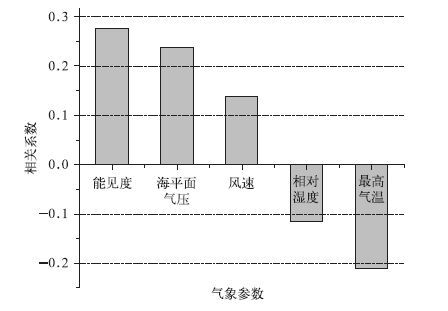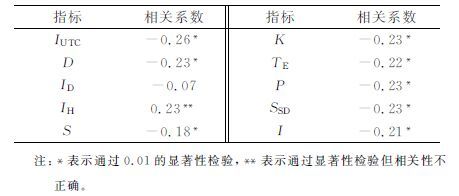2. 南京信息工程大学大气物理学院, 南京 210044;
3. 南京信息工程大学环境科学与工程学院, 南京 210044;
4. 国家气候中心, 北京 100081
2. College of Atmospheric Physics, Nan jing University of In formation Science & Technology, Nanjing 210044;
3. College of Environmental Science and Engineering, Nan jing University of Information Science & Technology, Nanjing210044;
4. National Climate Center, Beijing 100081
IPCC第4次评估报告指出,1950年以来,全球高温热浪发生频率明显增加[1],在此背景下,高温热浪对人体健康的影响研究引起了国内外的广泛关注,研究表明,热浪易引发人群中暑,导致居民死亡数增加[2-5],同时,国内外也广泛开展了高温热浪对人体健康影响的指标体系研究[6-12]。自20世纪60年代末,丹麦学者Fanger提出的热舒适方程,开创了热量平衡模型在人类生物气象学应用的先河,此后,众多学者建立了大量的人体热量平衡模型[6-7,13-14]和舒适度指标[15-19]。
近年来,国内众多学者分析了气象因素与中暑及人体舒适度之间的关系,研究制定了诸多舒适度指标及评定方法[6,9,20-24],并广泛开展了热舒适指标在空调、采暖、电力预测、奥运会期间的舒适度分析和气象旅游资源适宜性分析等方面的应用研究[25-31]。然而,目前国内的舒适度指标多为经验公式,考虑太阳辐射和气压对人体舒适度的影响较少;而且对于舒适度指标结合数值天气预报结果,在人体舒适度预报中适用性研究鲜见报道。因此,本文通过引进并修正热气候指数 (Universal Thermal Climate Index, UTCI),基于问卷调查资料,将该指标与国内外多种体感指标进行比较验证,以期揭示热气候指数在南京市的适用性;论证了该指标结合天气预报和辐射数值模型计算的结果,预报人体舒适度可行性。研究内容有助于提高公共气象服务质量,对减小南京市的高温危害、保障公民正常生活和生命财产安全有着重要的现实意义。
1 资料和方法 1.1 问卷调查为了验证舒适度指标,2009年8月21-25日,针对南京信息工程大学2008级军训学生开展了连续5d的问卷调查。主要场所为南京信息工程大学中苑操场。南京属亚热带湿润气候,年平均气温为15.3 ℃,年降水量为1106.5 mm, 8月平均气温为35 ℃左右,极端最高气温可达40 ℃左右。
1.1.1 调查对象及调查数据的可靠性本次问卷调查对象为205人 (其中男生120人,女生85人),年龄为18~22周岁;主要来自全国21个省、市和自治区,在南京居住的平均时间长度为12个月左右 (表 1)。
|
|
表 1 调查对象来源省份的人数及在南京滞留时长 Table 1 Frequency of interviewees from different provide with their staying time in Nanjing |
根据本次问卷调查所得到的数据表明:南京本地生源较少 (江苏南京籍学生11人),而非江苏南京籍学生基本是第1次经历南京的炎热夏季;被调查对象文化知识素养高,具有气象专业知识基础,填写的内容更具客观性;被调查对象均在同一场所,受天气、环境等因素影响一致,更能凸显个人感觉差异;户外活动时间长,受树阴等客观因素影响小,具有代表性;被调查对象为青壮年,不受心脏病、高血压、冠心病等老年病的影响,更能代表普通人的感受。
1.1.2 数据处理方法调查对象对热环境的感觉有“3级"、“5级"和“7级"3种处理方式,而众多学者指出“5级"较其他两种处理方式更合理[32-34],因此,采取“5级"数值处理方式进行统计分析 (表 2)。同时,鉴于国外学者的研究方法[12,35-36],根据表 2将问卷调查的人体舒适度选项数值化,并将每天每份有效问卷中的舒适度与当日气象要素和各舒适指标值相对应,计算相关系数,由于本次调查有效问卷共计749份,所以样本量n=749。
|
|
表 2 问卷中选项对应的等级 Table 2 The option grade in questionnaire survey |
1.2 气象数据
本文的最高气温、云量、相对湿度、气压和风速均由南京信息工程大学气象观测站提供 (表 3,时间为北京时,下同)。该观测站位于问卷调查地点西侧,相互间距离约为400m, 室外热环境与南京信息工程大学中苑操场十分相似。
|
|
表 3 调查站点的日最高气温、云量、相对湿度、气压和风速 Table 3 The datebase of maximum temperature, cloud cover, relative humidity and wind speed |
2 舒适度指标
根据涵盖的气象参数,热指数可分为单要素、二要素、三要素和多要素指数[37]。单要素一般用最高温度高于某一温度 (阈值),如30 ℃,35 ℃或40 ℃等,或者高于某一温度以上连续多少小时或者多少天数作为指标。
2.1 二要素指数温湿指数是最典型的二要素。邹旭恺[25]采用炎热指数D计算长江三峡库区舒适度:

|
(1) |
式 (1) 中,T为空气温度 (单位:℃),HR为相对湿度 (单位:%)。

|
(2) |
美国国家天气局[40]使用热指数 (Heat Index, IH) 来评价人在夏季的不舒适状况:

|
(3) |
一般的三要素指标是指除温度与相对湿度之外,还考虑了风速 (V,单位:m·s-1)。南宁市的体感温度TE计算公式为[41]:

|
(4) |
江苏省气象台在查阅了国内外关于人体舒适度的理论研究的基础上,根据本地气候特征,研制了具有地方特色的数学模式 (P指标):

|
(5) |
陆鼎煌等提出综合舒适度指标S为[42]:

|
(6) |
张书余提出的舒适度指数K计算方法为[21]:

|
(7) |
天津市气象局使用了与南昌市和上海市相似的人体舒适度指数I预报模型[22]:

|
(8) |
山东省[43]各气象台站业务使用的人体舒适度指数SSD计算公式预报公式为:

|
(9) |
式 (9) 中,Tmax(单位:℃) 为当日最高气温;HRmax为当日最高相对湿度。
2.4 热气候指数 (UTCI) 的引进与修正根据问卷调查分析结果,分析了主要气象要素 (温度、相对湿度、风速、气压和太阳辐射) 与人体舒适度的线性相关系数 (图 1),表明线性相关性由大到小的顺序为:能见度,气压,最高气温,风速,相对湿度。众多学者已经指出能见度与太阳辐射之间存在紧密关系[44-48];因此,在夏季室外热环境中,太阳辐射对人体舒适度影响较最高气温大,这与国外最新研究结论是一致的[49-51]。根据上述分析及国内现行体感指数状况,必须引进考虑太阳辐射和气压对人体舒适度影响的指标,以进一步提高公共气象服务质量。

|
|
| 图 1. 舒适度与主要气象参数之间相关系数 (n=749,均通过0.01的显著性检验) Fig 1. The correlation coefficients between thermal comfort and meteorological factors (n=749, passing the test of 0.01 level) | |
国际生物气象学会根据近年主要体感模型和指标制定了一系列体感指标计算公式。根据2007年9月1日的UTCI指标计算[52]程序,结合国内指数计算公式,得到南京市的热气候指数 (UTCI) 的计算公式为:

|
(10) |
式 (10) 中,tmrt(单位:℃) 为14:00的辐射温度与最高温度的差值,p(单位:hPa) 为14:00气压。
3 指标验证为了增强热气候指数UTCI在人体舒适度预报中的适用性,根据太阳高度角H和云量N,利用SolAlt模型[53]计算太阳辐射,公式如下:

|
(11) |

|
(12) |

|
(13) |

|
(14) |

|
(15) |
其中,R为辐射强度 (单位:W·m-2·s-1),a为皮肤或 (和) 服装的反射率 (一般取31%)。而辐射温度Tmrt(单位:℃) 有多种计算方式,在实际应用中可以通过计算裸体吸收的太阳辐射来计算[54],即

|
(16) |
根据实际观测数据和SolAlt模型计算结果所得的各种指标值如表 4。表 5表明,国内体感指标与人体舒适度之间的相关性均能通过0.01(n=749) 的显著性检验,基本能够反映人体的真实感受,其效果远好于美国的IH温湿效应指标和英国的ID指标。比较而言,热气候指数不仅考虑了太阳辐射和气压对人体舒适度的影响,而且与人体实际热感觉的相关系数最大,能够更好地表征夏季热环境对人体热舒适的影响。
|
|
表 4 根据SolAlt模型和观测数据计算的太阳辐射和各指标值 Table 4 The solar radiation and indices calculated by SolAtt model and observed data |
|
|
表 5 各指标与问卷调查所得的人体舒适度之间的相关系数 Table 5 The correlation coefficients between thermal com fort accor ding to questionnaire surveys and indices |
4 小结
国内的人体舒适指标都是以温湿指数为基础的各式各样变形[25],而考虑太阳辐射对人体作用的鲜见报道;但众多学者指出,在室外热环境中,热辐射是影响人体舒适度的重要因素之一[35,55-57]。而夏季热环境中,气压对人体作用一直被人们所忽视,但问卷调查结果表明夏季室外热环境中,主要气象要素与人体舒适度的线性相关性从大到小依次为:太阳辐射,温度,气压,风速,相对湿度。因此,在建立舒适度指标时,除温度、湿度和风速之外,必须考虑太阳辐射和气压对人体舒适度的影响。
目前国内的各种体感指标基本能够反映热环境对人体的热胁迫,其效果要远好于美国的IH温湿效应指标和英国的ID指标;但这些指标均没有考虑太阳辐射和气压对人体舒适度的影响,仍需进一步完善与改进。
修正后的热气候指数较其他舒适度指标能够更好地表征人体的实际热感觉。而我国气象预报部门主要数值天气预报模式MM5和WRF模型已发展得十分成熟,基本可以保证温、湿、风、压的预报精确度[58-61]。太阳辐射预报的精确度是热气候指数预报人体舒适度效果的关键因素。目前,计算太阳辐射的模型主要有Ångström, Bahel, SolDir, SolG1ob和SolAlt模型,其中Ångström和Bahel模型需要实际日照时数,SolDir模型需要直射、散射和反射辐射通量,SolG1ob需要太阳总辐射[53,62-64],它们均不适合作为太阳辐射的预报模型。而气象部门预报的云量,能够满足SolAlt模型预报太阳辐射的要求,这就保证了热气候指数预报人体舒适度的可行性。因此,结合天气预报数值模型预报的温度、风速、湿度、气压和SolAlt模型预报的太阳辐射,修正后的热气候指数非常适宜作为南京市的人体舒适度预报指标。
| [1] | Le Treut, Somerville H, Cubasch R U, et al.Historical Overview of Climate Change∥ Climate Change 2007:The Physical Science Basis.Contribution of Working Group I to the Fourth Assessment Report of the Intergovernmental Panel on Climate Change.2007. |
| [2] | Semenza J C, Rubin C H, Falter K H, et al, Heat-related deaths during the July 1995 heat wave in Chicago. N Engl J Med, 1996, 335: 84–90. DOI:10.1056/NEJM199607113350203 |
| [3] | Keatinge W R, Donaldson G C, Cordioli E, et al. Heat related mortality in warm and cold regions of Europe:Observational study. Br Med, 2000, 321: 670–673. DOI:10.1136/bmj.321.7262.670 |
| [4] | Huynen M, Martens P, Schram D, et al. The impact of heat waves and cold spells on mortality ratesin the Dutch population. Environ Health Perspect, 2001, 109: 463–470. DOI:10.1289/ehp.01109463 |
| [5] | Kalkstein L S, Greene J S, An evaluation of climate/mortality relationships in large U.S.cities and the possible impacts of a climate change. Environ Health Perspect, 1997, 105: 84–93. DOI:10.1289/ehp.9710584 |
| [6] | 谈建国. 气候变暖?城市热岛与高温热浪及其健康影响研究. 南京: 南京信息工程大学, 2008: 8-11. |
| [7] | H?ppe P R, Heat balance modelling. Experientia, 1993, 49, (12): 741–746. |
| [8] | 吕伟林. 体感温度及其计算方法. 北京气象, 1998, (1): 23–25. |
| [9] | 余永江. 基于人体与环境热量平衡模型的中暑等级预报. 南京: 南京信息工程大学, 2008: 47-126. |
| [10] | Jang M S, Koh C D, Moon I S, Review of thermal comfort design based on PMV/PPD in cabins of Korean maritime patrol vessels. Building and Environment, 2007, 42: 55–61. DOI:10.1016/j.buildenv.2005.07.025 |
| [11] | Erik Johansson, Influence of urban geometry on outdoor thermal comfort in a hot dry climate:A study in Fez, Morocco. Building and Environment, 2006, 41: 1326–1338. DOI:10.1016/j.buildenv.2005.05.022 |
| [12] | Berger X, Human thermal comfortat Nîmes in summer heat. Energy and Buildings, 2001, 33: 283–287. DOI:10.1016/S0378-7788(00)00093-1 |
| [13] | Mat Zarakis A, Mayer H, Heat stress in Greece. Int J Biomereorol, 1997, 41, (1): 34–39. DOI:10.1007/s004840050051 |
| [14] | Anderson G S, Martin A D, Caleulated thermal conductivities and heat flux in man. Undersea & Hyperbaric Medicine, 1994, 21, (4): 431–41. |
| [15] | Fanger P O, Thermal comfort. New York: McGraw Hill, 1972. |
| [16] | Jeongho Kang, SeKwang Park, Development of comfort sensing system for human environment. Mechatronics, 1998, 8: 459–466. DOI:10.1016/S0957-4158(98)00015-4 |
| [17] | Gagge A P, Fobelets A P, Berglund L G, A standard predictive index of human response to the thermal environment. ASHRAE Transactions, 1986, 92: 709–731. |
| [18] | Pickup J, de Dear R J.An Outdoor Thermal Comfort Index (OUT_SET*)—Part I—the Model and Its Assumptions∥ de Dear R J, Kalma J D, Oke T R.et al.Biometeorology and Urban Climatology at the Turn of the Millonium.Selected Papers from the ICB-ICUC'99 Conference, Sydney, WCASP-50, WMO/TD No.1026.Geneva:World Meteorological Organization, 2000. |
| [19] | Höppe P, The physiological equivalent temperature-a universal index for the biometeorological assessment of the thermal environment. International Journal of Biometeorology, 1999, 43: 71–76. DOI:10.1007/s004840050118 |
| [20] | 王长来, 茅志成, 程极壮. 气象因素与中暑发生关系的探讨. 气候与环境研究, 1999, 4, (1): 40–43. |
| [21] | 张书余. 城市环境预报技术. 北京: 气象出版社, 2002: 124-126. |
| [22] | 吴兑, 邓雪娇. 环境气象学与特征天气预报. 北京: 气象出版社, 2001: 162-189. |
| [23] | 徐大海, 朱蓉. 人对温度?湿度?风速的感觉与着衣指数的分析研究. 应用气象学报, 2000, 11, (4): 430–439. |
| [24] | 陈辉, 黄卓, 田华, 等. 高温中暑气象等级评定方法. 应用气象学报, 2009, 20, (4): 451–457. |
| [25] | 邹旭恺. 长江三峡库区旅游气候资源评估. 气象, 2003, 29, (11): 55–57. |
| [26] | 陈莉, 李帅, 周永吉, 等. 用标准有效温度和不舒适指标研究哈尔滨热舒适状况. 气象, 2008, 34, (1): 72–79. |
| [27] | 刘瑾. 基于PMV指标的空调系统舒适控制研究. 长沙:湖南大学, 2003: 32–34. |
| [28] | 秦海超, 王玮, 周晖, 等. 人体舒适度指数在短期电力负荷预测中的应用. 电力系统及其自动化学报, 2006, 18, (2): 63–66. |
| [29] | 刘清春, 王铮, 许世远. 中国城市旅游气候适应性分析. 资源科学, 2007, 29, (1): 133–141. |
| [30] | 邢娜. 热舒适条件下的船舶空调节能研究. 上海: 上海海事大学, 2007. |
| [31] | 朱燕君, 陈峪, 李庆祥. 北京奥运会期间的气象条件分析. 应用气象学报, 2006, 17, (增刊): 35–41. |
| [32] | Mayer H, Urban bioclimatology. Birkhfäuser Verlag Basel, 1993, 49, (11): 957–963. |
| [33] | Nikolopoulou M, Lykoudis S, Thermal comfort in outdoor urban spaces:Analysis across different European countries. Building and Environment, 2006, 41: 1455–1470. DOI:10.1016/j.buildenv.2005.05.031 |
| [34] | De Dear R J, Fountain M E, Field experiments on occupant comfort and office thermal environments in a hot-humid climate. ASHRAE Transactions, 1994, 100: 457–474. |
| [35] | Nikolopoulou M, Baker N, Steemers K, Thermal comfort inoutdoor urban spaces:Understanding the human parameter. SolarEnergy, 2001, 70: 227–235. |
| [36] | Theodore Stathopoulos, Wu Hanqing, Zacharias John, Outdoor human comfort in an urban climate. Building and Environment, 2004, 39: 297–305. DOI:10.1016/j.buildenv.2003.09.001 |
| [37] | 刘建军, 郑有飞, 吴荣军. 热浪灾害对人体健康的影响及其方法研究. 自然灾害学报, 2008, 17, (1): 155–160. |
| [38] | Tout D G, The diseomfort index, mortality and the London Summers of 1976 and 1978. Int J Biomeyeorol, 1980, 24, (4): 323–328. DOI:10.1007/BF02250574 |
| [39] | Matzarakis A, Mayer H, The extreme heat wave in Athensin July 1987 from the point of view of human biometeorology. Atmos Environ, 1991, 25: 203–211. DOI:10.1016/0957-1272(91)90055-J |
| [40] | http://en.wikiPedia.org/wiki/Heat_index. |
| [41] | 董蕙青, 黄香杏, 郑宏翔. 中暑指数预报. 广西气象, 2000, 21, (2): 47–48. |
| [42] | 陆鼎煌, 崔森. 北京城市绿化夏季小气候条件对人体的适宜度∥中国农学会农业气象研究会, 中国林学会. 林业气象论文集. 北京: 气象出版社, 1984: 144-152. |
| [43] | 杨成芳, 薛德强, 李长军. 山东省人体舒适度区域特征研究. 气象, 2004, 30, (10): 7–11. |
| [44] | Li F, Lu D, Features of aerosol optical depth with visibility grde over Beijing. Atmospheric Environment, 1997, 31, (20): 3413–3419. DOI:10.1016/S1352-2310(97)83211-6 |
| [45] | 孙娟. 气溶胶光学厚度的高光谱遥感反演及其环境效应. 上海: 华东师范大学, 2006: 64-67. |
| [46] | Qiu J H, Yang L Q, Variation characteristies of atmospheric aerosol optical depths and visibility in North China during 1980-1994. Atmospheric Enviromnent, 2000, 34, (4): 603–609. DOI:10.1016/S1352-2310(99)00173-9 |
| [47] | Martonchik J V, Ding D J, Teehniques for the rertieval of aerosol properties over land And ocean using mutiangle imaging. IEEE Transactions on Geoseience and Remoet Sensing, 1998, 16, (4): 1212–1227. |
| [48] | 许潇锋. 中国地区气溶胶光学特性研究. 南京: 南京信息工程大学, 2008: 92-96. |
| [49] | Ali-Toudert F, Mayer H, Numerical study on the effects of aspect ratio and orientation of an urban street canyon on outdoor thermal comfort in hot and dry climate. Building and Environment, 2006, 41: 94–108. DOI:10.1016/j.buildenv.2005.01.013 |
| [50] | Ali-Toudert F, Mayer H, Effects of asymmetry, galleries, overhanging facades and vegetation on thermal comfort in urban street canyons. Solar Energy, 2007, 81: 742–754. DOI:10.1016/j.solener.2006.10.007 |
| [51] | Lin Tzu-Ping, Andreas Matzarakis, Hwang Ruey-Lung, Shading effect on long-term outdoor thermal comfort. Building and Environment, 2010, 45, (1): 213–221. DOI:10.1016/j.buildenv.2009.06.002 |
| [52] | http://www.utci.org/. |
| [53] | Blazejiczyk K.MENEX_2002.http://www.igipz.Pan.pl/kli-mat/blaz/menex.html, 2002. |
| [54] | Thorsson S, Lindberg F, Eloassonl, et al. Different methods for estimating the mean radiant temperature in an outdoor urban setting. International Journal of Climatology, 2007, 27, (14): 1983–1993. DOI:10.1002/(ISSN)1097-0088 |
| [55] | Thorsson S, Lindqvist M, Lindqvist S, Thermal bioclimatic conditions and patterns of behaviour in an urban parkin Goteborg, Sweden. International Journal of Biometeorology, 2004, 48: 149–256. DOI:10.1007/s00484-003-0189-8 |
| [56] | Eliasson I, Knez I, Westerberg U, et al. Climate and behaviour in a Nordic city. Landscapeand Urban Planning, 2007, 82: 72–84. DOI:10.1016/j.landurbplan.2007.01.020 |
| [57] | Thorsson S, Honjo T, Lindberg F, et al. Thermalcomfort and outdoor activity in Japanese urban public places. Environment and Behavior, 2007, 39: 660–684. DOI:10.1177/0013916506294937 |
| [58] | 伍华平. 暴雨模拟中积云对流参数话方案的对比试验. 上海: 华东师范大学, 2008: 1-3. |
| [59] | 李俊, 沈铁元, 宋星原, 等. AREM中尺度暴雨模式降水预报试验. 武汉大学学报 (工学版), 2007, 40, (1): 15–19. |
| [60] | 杨洪平, 张沛源, 程明虎, 等. 多普勒天气雷达短时预报技术研究进展. 暴雨灾害, 2007, 26, (2): 90–96. |
| [61] | 周昆, 王东勇, 朱红芳. 中尺度数值模式在IBMP690上的并行测试. 气象科学, 2006, 26, (6): 651–654. |
| [62] | ÅngströmA. Solar and atmopheric radiation. Q J R Met Soc, 1924, 50: 121–125. |
| [63] | Wong L T, Chow W K, Solar radiation model. AppliedEnegry, 2001, 69: 191–224. |
| [64] | Lin T P, Thermal perception, adaptation and attendance in a public square in hot and humid regions. Building and Environment, 2009, 44: 2017–2026. DOI:10.1016/j.buildenv.2009.02.004 |
 2010, 21 (6): 709-715
2010, 21 (6): 709-715






